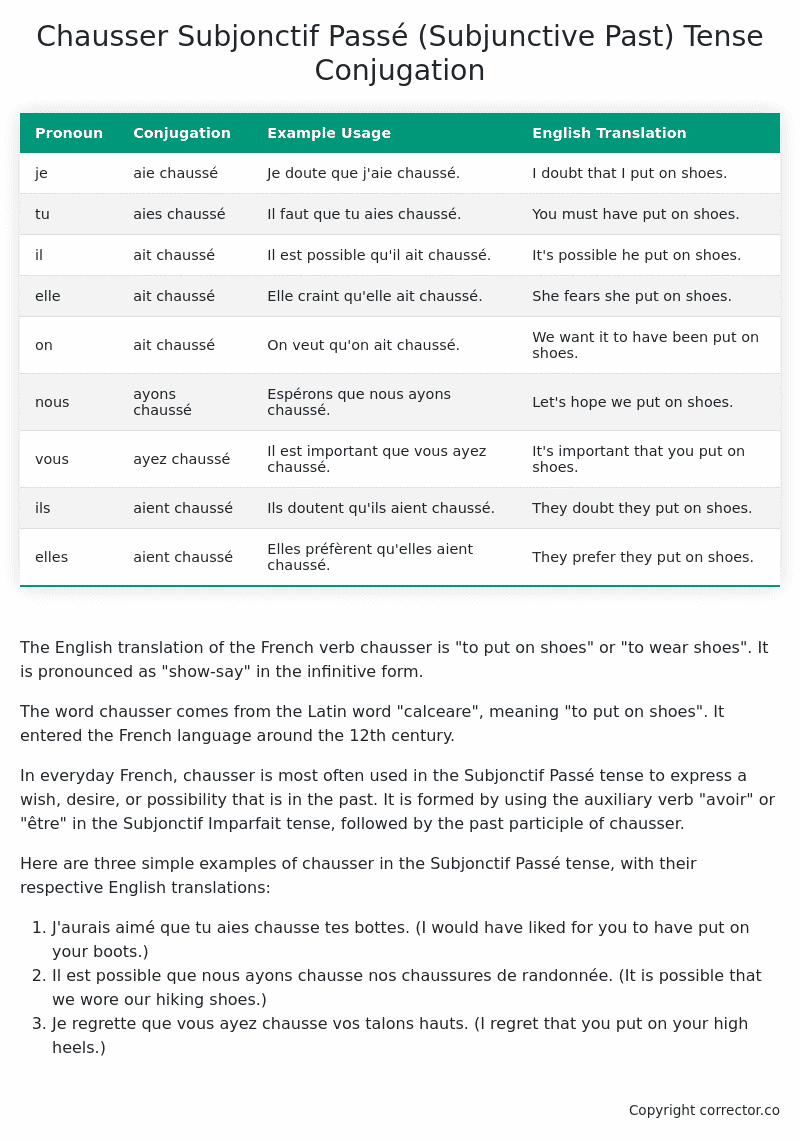Subjonctif Passé (Subjunctive Past) Tense Conjugation of the French Verb chausser
Introduction to the verb chausser
The English translation of the French verb chausser is “to put on shoes” or “to wear shoes”. It is pronounced as “show-say” in the infinitive form.
The word chausser comes from the Latin word “calceare”, meaning “to put on shoes”. It entered the French language around the 12th century.
In everyday French, chausser is most often used in the Subjonctif Passé tense to express a wish, desire, or possibility that is in the past. It is formed by using the auxiliary verb “avoir” or “être” in the Subjonctif Imparfait tense, followed by the past participle of chausser.
Here are three simple examples of chausser in the Subjonctif Passé tense, with their respective English translations:
- J’aurais aimé que tu aies chausse tes bottes. (I would have liked for you to have put on your boots.)
- Il est possible que nous ayons chausse nos chaussures de randonnée. (It is possible that we wore our hiking shoes.)
- Je regrette que vous ayez chausse vos talons hauts. (I regret that you put on your high heels.)
Table of the Subjonctif Passé (Subjunctive Past) Tense Conjugation of chausser
| Pronoun | Conjugation | Example Usage | English Translation |
|---|---|---|---|
| je | aie chaussé | Je doute que j’aie chaussé. | I doubt that I put on shoes. |
| tu | aies chaussé | Il faut que tu aies chaussé. | You must have put on shoes. |
| il | ait chaussé | Il est possible qu’il ait chaussé. | It’s possible he put on shoes. |
| elle | ait chaussé | Elle craint qu’elle ait chaussé. | She fears she put on shoes. |
| on | ait chaussé | On veut qu’on ait chaussé. | We want it to have been put on shoes. |
| nous | ayons chaussé | Espérons que nous ayons chaussé. | Let’s hope we put on shoes. |
| vous | ayez chaussé | Il est important que vous ayez chaussé. | It’s important that you put on shoes. |
| ils | aient chaussé | Ils doutent qu’ils aient chaussé. | They doubt they put on shoes. |
| elles | aient chaussé | Elles préfèrent qu’elles aient chaussé. | They prefer they put on shoes. |
Other Conjugations for Chausser.
Le Present (Present Tense) Conjugation of the French Verb chausser
Imparfait (Imperfect) Tense Conjugation of the French Verb chausser
Passé Simple (Simple Past) Tense Conjugation of the French Verb chausser
Passé Composé (Present Perfect) Tense Conjugation of the French Verb chausser
Futur Simple (Simple Future) Tense Conjugation of the French Verb chausser
Futur Proche (Near Future) Tense Conjugation of the French Verb chausser
Plus-que-parfait (Pluperfect) Tense Conjugation of the French Verb chausser
Passé Antérieur (Past Anterior) Tense Conjugation of the French Verb chausser
Futur Antérieur (Future Anterior) Tense Conjugation of the French Verb chausser
Subjonctif Présent (Subjunctive Present) Tense Conjugation of the French Verb chausser
Subjonctif Passé (Subjunctive Past) Tense Conjugation of the French Verb chausser (this article)
Subjonctif Imparfait (Subjunctive Imperfect) Tense Conjugation of the French Verb chausser
Subjonctif Plus-que-parfait (Subjunctive Pluperfect) Tense Conjugation of the French Verb chausser
Conditionnel Présent (Conditional Present) Tense Conjugation of the French Verb chausser
Conditionnel Passé (Conditional Past) Tense Conjugation of the French Verb chausser
L’impératif Présent (Imperative Present) Tense Conjugation of the French Verb chausser
L’infinitif Présent (Infinitive Present) Tense Conjugation of the French Verb chausser
Struggling with French verbs or the language in general? Why not use our free French Grammar Checker – no registration required!
Get a FREE Download Study Sheet of this Conjugation 🔥
Simply right click the image below, click “save image” and get your free reference for the chausser Subjonctif Passé tense conjugation!

Chausser – About the French Subjonctif Passé (Subjunctive Past) Tense
Formation of the Subjonctif Passé
Everyday Usage Patterns
Interactions with Other Tenses
Present tense
Future tense
Conditional
Summary
I hope you enjoyed this article on the verb chausser. Still in a learning mood? Check out another TOTALLY random French verb conjugation!


